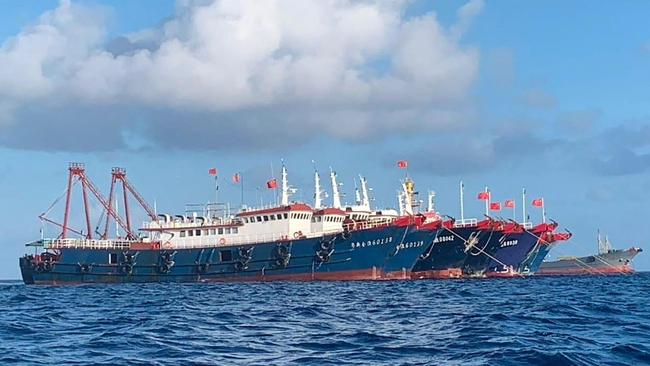
“I am no fool. The weather has been good so far, so they have no reason to stay there,” fumed Philippines Defence Minister Delfin Lorenzana in a weekend statement that accused China of using civilian maritime militia forces to occupy land forms inside Philippines waters.
“They have done this before at Panatag Shoal and at Panganiban Reef, brazenly violating Philippine sovereignty and sovereign rights under international law,” he said, using The Philippines names for Scarborough Shoal and Mischief reef — both seized by Beijing in recent years.
The response from China, which in February passed new laws allowing its coastguard to fire on foreign vessels, was as familiar to Manila as it was infuriating. “The waters around Niu’e Jiao has been a traditional fishing ground for Chinese fishermen for many years,” its Philippines embassy said, using Beijing’s name for the Whitsun Reef that lies within The Philippines exclusive economic zone.
“It is completely normal for Chinese fishing vessels to fish in the waters and take shelter near the reef during rough sea conditions.”
Tensions between the two neighbours are broiling over China’s repeated exploitation of the grey zone, just short of conflict, to colonise disputed territory in the South China Sea, a strategic waterway through which more than one-third of the world’s annual trade passes.
Beijing says the fleet of pristine ships, anchored 300km from The Philippines’ Palawan province since early March, are fishing vessels taking safe harbour. Philippines authorities insist none of the vessels has done any fishing in the past month, and they are in fact part of China’s “maritime militia”, which operates under the orders of the Coast Guard and People’s Liberation Army.
“The continued presence of Chinese maritime militias in the area reveals their intent to further occupy (areas) in the West Philippine Sea,” Lorenzana said on Sunday, noting 44 of the vessels remained in the area.
A spokesman for President Rodrigo Duterte warned on Monday that the incident was straining ties and could “trigger unwanted hostilities” between the two nations.
“We can negotiate on matters of mutual concern and benefit, but make no mistake about it — our sovereignty is non-negotiable,” Salvador Panelo said.
Foreign Minister Teddy Locsin has threatened to file diplomatic protests for every day the fleet remains in the area.
Notwithstanding the bluster, Philippines maritime analyst Jay Batongbacal says Manila has “no appetite for actual confrontation”. “Duterte needs China to provide vaccines to shore up his shattered credibility,” he said.
Beijing has been at odds for years with at least five Asian neighbours — The Philippines, Brunei, Malaysia, Vietnam and Taiwan — over its aggressive claim to more than 90 per cent of the South China Sea, which a UN arbitral tribunal rejected in 2016.
That hasn’t stopped it from building up disputed islands and reefs, and constructing military bases and air strips on them.
Analysts say China’s latest incursion is not just about claiming more territory but about testing the Biden administration’s commitment to its decades-old defence treaty with Manila that commits it to aiding The Philippines against hostile forces. Last year the Trump administration made explicit that the pact covered any hostilities The Philippines faced in the South China Sea. Joe Biden has reaffirmed that commitment.
“If your goal is to take over a sea space and atoll without fighting for it, this is a brilliant if dishonest tactic,” Carl Schuster, a maritime analyst and former operations director at US Pacific Command’s Joint Intelligence Centre, told Bloomberg on Tuesday. “It is a test to see what the administration is willing to do.”
Whether Beijing deliberately set out to test Joe Biden, Batongbacal agrees the current stand-off “certainly (provides) the opportunity for them to do so”.
He says the most likely explanation for the Chinese fleet’s presence is to deploy “reserve forces that can be called upon to (quickly) enforce China’s dominance in the South China Sea”.
“Whitsun Reef being added to China’s array of artificial island bases would be a significant escalation and a worrying development.”




The waters have been calm around the Whitsun Reef in the South China Sea’s disputed Spratly Island chain, yet that hasn’t stopped more than 200 Chinese ships from laying anchor there against what Beijing has insisted for weeks is an imminent storm.